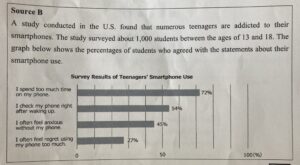2022年の11月に公表された
令和7年度大学入学共通テスト
試作問題『英語(リーディング)』の、第A問、第B問の解説です。
試作問題作成の趣旨及び留意点
①令和7年度大学入学共通テスト『英語(リーディング)』の問題作成の工夫について、
具体的なイメージを共有するために・公表するものである
②本試作問題は、出題する問題の一例である。
本誌作問題と同じような内容、形式、配点等の問題が、令和7年度以降必ず出題
されるものではない。
③本試作問題は専門家により作成されたものだが、過去の大学入試センター試験や
大学入学共通テストと同様の問題作成や点検のプロセスを経たものではない。
それでは、
これを踏まえた上で
第A問に挑戦してみましょう。
第A問
You are working on an essay about whether high school students should be allowed to use their smartphones in class. You will the steps below.
Step 1: Read and understand various viewpoints about smartphone use.
Step 2: Take a position on high school students’ use of their smartphones in class.
Step 3: Create an outline for an essay using additional sources.
[Step 1] Read various sources
My colleagues often question wether smartphones can help students develop
life-long knowledge and skills. I believe that they can, as long as their use is
carefully planned. Smartphones support various activities in class that can
enhance learning. Some examples include making surveys for projects and
sharing one’s learning with others. Another advantage is that we do not have
to provide students with devices; they can use their phones! Schools should
take full advantage of students’ powerful computing devices.
It is a widespread opinion that smartphones can encourage student learning.
Being believed by many, though, does not make an opinion correct. A recent
study found that when high school students were allowed to use their
smartphones in class, it was impossible for them to concentrate on learning. In fact, even if students were not using their own smartphones, seeing their
classmates using smartphones was a distraction. It is clear that schools should make the classroom a place that is free from the interference of smartphones.
I recently bought a smartphone for my son who is a high school student. This
is because his school is located far from our town. He usually leaves home
early and returns late. Now, he can contact me or access essential information if he has trouble. On the other hand, I sometimes see him walking while looking at his smartphone. If he is not carful, he could have an accident. Generally, I think that high school students are safer with smartphones, but parents still need to be aware of the risks. I also wonder how he is using it in class.
At school, we are allowed to use our phones in class. It makes sense for our
school to permit us to use them because most students have smartphones.
During class, we make use of foreign language learning apps on our
smartphones, which is really helpful to me. I am now more interested in
learning than I used to be, and my test scores have improved. The other day,
though, my teacher got mad at me when she caught me reading online comics in class. Occasionally these things happen, but overall, smartphones have improved my learning.
Teachers at my school were initially skeptical of smartphones because they
thought students would use them to socialize with friends during class. Thus,
we banned them. As more educational apps became available, however, we
started to think that smartphones could be utilized as learning aids in the
classroom. Last year, we decided to allow smartphones use in class.
Unfortunately, we did not have the results we wanted. We found that smartphones distracted students unless rules for their use were in place
and students followed them. This was easier said than done, though.
② one reason to use smartphones as an educational tool is that most students
possess one
③ smartphones can be used to support activities for learning both at school
at home
④ smartphones make it possible for students to share their ideas with classmates
to learn
② sometimes commonly held beliefs can be different from the facts that
research reveals
③ students who do not have smartphones are likely to consider themselves
better learners
④ the classroom should be a place where students can learn without the
interference of teachers
on high school students’ use of their smartphones in class, and have written it
out as below. Choose the best options to complete 【 3 】, 【 4 】 and
【 5 】.
④ D
⑤ E
① Making practical rules for smartphone use in class is difficult for school
teachers
② Smartphones may distract learning because the educational apps are difficult
to use
learning
④ Students cannot focus on studying as long as they have access to smartphones in class
Introduction
Smartphones have become essential for modern life, but students be
should prohibited from using their phones during class.
Body
Reason 1: [ From Step 2 ]
Reason 2: [ Based on Source A ] ・・・・・【 6 】
Reason 3: [ Based on Source B ]・・・・・【 7 】
Conclusion
High schools should not allow students to use their smartphones in class.
Mobile devices offer advantages for learning. For example, one study showed
that university students learned psychology better when using their interactive mobile apps compared with their digital textbooks. Although
the information was the same, extra features in the apps, such as 3D images, enhanced students’ learning. It is important to note, however, that digital
devices are not all equally effective. Another study found that students understand content better using their laptop computers rather than their smartphones because of the larger screen size. Schools must select the type of digital device that will maximize students’ learning, and there is a strong argument for schools to provide computers or tablets rather than to have students use their smartphones. If all students are provided with computers or tablets with the same apps installed, there will be fewer technical problems and it will be easier for teachers to conduct class. This also enables students without their own smartphones to participate in all class activities.
Reason 2? 【 6 】
have these apps on their smartphones.
② Certain kinds of digital devices can enhance educational effectiveness, but
smartphones are not the best.
other devices to prepare for university.
④ We should stick to textbooks because psychology studies have not shown
the positive effects of digital devices on learning.
danger of smartphone addiction.” Based on Source B, which option beset supports this statement? 【 7 】
too much, less than a quarter actually feel regret about it. This may indicate
unawareness of a dependency problem.
② Close to three in four teenagers spend too much time on their phones. In
fact, over than 50% check their phones immediately after working. Many
teenagers cannot resist using their phones.
③ Over 70% of teenagers think they spend too much time on their phones,
and more than half feel anxious without them. This kind of dependence can
negatively impact their daily lives.
④ Teenagers are always using smartphones. In fact, more than three-quarters
admit to using their phones too much. Their lives are controlled by smartphones
from morning to night.
問題の設定
・一番最初に、この問題の設定が書かれています。
You are working on an essay about whether high school students should be
allowed to use their smartphones in class. You will follow the steps below.
ーがその設定です。
内容は、
「あなたは授業で高校生がスマートフォンを使うことを許されるべきかどうかについての
エッセイに取り掛かっています。あなたは以下のステップを踏んでいきます。」
とあり、
その後に3ステップが示されて、
そのステップごとにさまざまな意見や資料が提示され、ステップごとに
問題がある、という展開になっています。
それでは
まずは、 それぞれのステップを見てみましょう。
Step 1 〜 3 まで
Step.1:Read and understand various viewpoints about smartphone use.
Step 2:Take a position on high school students’ use of their smartphones in class.
Step 3:Create an outline for an essay using additional sources.
それぞれの意味は下記の通り。
ステップ1
▶︎スマートフォン使用についての様々な意見を読んで理解する
ステップ2
▶︎授業での高校生のスマートフォン使用に関する立ち位置を示す
ステップ3
▶︎補足的な資料を用いてエッセイの概要を作る
それでは、それぞれのステップの具体的内容を見ていきます。
Step 1 Read various sources
ここでは、Author A 〜E までの意見が示されています。
その内容を確認すると次のようになります。
Author A (Teacher:教師)
My colleagues often question wether smartphones can help students develop
life-long knowledge and skills. I believe that they can, as long as their use is
carefully planned. Smartphones support various activities in class that can
enhance learning. Some examples include making surveys for projects and
sharing one’s learning with others. Another advantage is that we do not have
to provide students with devices; they can use their phones! Schools should
take full advantage of students’ powerful computing devices.
👉私の同僚はよくスマートフォンが生徒に生涯の知識と技術を身につけさせることが
できるかどうかを質問します。私は使用の仕方がしっかりと計画されている限り可能
であると信じています。スマートフォンは学習を強化することができる授業での様々な
活動をサポートします。フロジェクトの調査をしたり他の人と学びを共有する実例も
あります。もう一つの長所は私たちが装置を生徒に提供する必要がないということです。
と言うのは彼ら自身が自分のスマホを持っているのですから。学校は生徒が持っている
強力なコンピュータデバイス(スマホ)をフルに活用すべきなのです。
Author B (Psychologist:心理学者)
It is a widespread opinion that smartphones can encourage student learning.
Being believed by many, though, does not make an opinion correct. A recent
study found that when high school students were allowed to use their
smartphones in class, it was impossible for them to concentrate on learning.
In fact, even if students were not using their own smartphones, seeing their
classmates using smartphones was a distraction. It is clear that schools should
make the classroom a place that is free from the interference of smartphones.
👉スマートフォンは生徒の学習によい効果を与えられるというのが広く言われている
意見です。しかし、多くの人に信じられているからといってその意見が正しいという
わけではありません。最近の研究では高校生が授業でスマホの使用を許されると、学習に
集中することが不可能であったということがわかりました。事実、例え生徒が自分自身の
スマホを使わないとしても、スマホを使っている同級生を見ると気がそがれることで
しょう。学校は教室をスマホの干渉がない場所にするべきことは明確です。
Author C (Parent:親)
I recently bought a smartphone for my son who is a high school student. This
is because his school is located far from our town. He usually leaves home
early and returns late. Now, he can contact me or access essential information if he has trouble. On the other hand, I sometimes see him walking while looking at his smartphone. If he is not carful, he could have an accident. Generally, I think that high school students are safer with smartphones, but parents still need to be aware of the risks. I also wonder how he is using it in class.
👉私は高校生の息子にスマホを買ってあげました。これは息子の学校が私たちの街から
遠い場所にあるからです。彼は普段は朝早く家を出て、遅くに帰ってきます。今では
彼がもし困ったことがあると私に連絡ができるし、必要な情報を手に入れることもでき
ます。その一方、私は時々スマホを見ながら彼が歩いているのを見かけます。気をつけ
なければ、事故に遭うかもしれません。一般的に私は高校生はスマホを持てば、より
安心だとおもいますが、保護者はそれでもそのリスクを認識する必要はあると思います。
私も彼が授業でスマホをどのように使うのかなあ、と思っています。
Author D (High school student:高校生)
At school, we are allowed to use our phones in class. It makes sense for our
school to permit us to use them because most students have smartphones.
During class, we make use of foreign language learning apps on our
smartphones, which is really helpful to me. I am now more interested in
learning than I used to be, and my test scores have improved. The other day,
though, my teacher got mad at me when she caught me reading online comics
in class. Occasionally these things happen, but overall, smartphones have
improved my learning.
👉学校で、私たちは授業でのスマホの使用を許可されています。大部分の生徒がスマホ
を持っているので私たちの学校がその使用を認めるのは理にかなったことです。授業の
間に、私たちはスマホの外国語学習アプリを使うのですが、とても私にとって役に立って
います。私は以前より学習により興味を持つようになったし、自分のテストの点数もよく
なっています。だけど、授業中に先生に私がオンラインの漫画を読んでいるのが見つかって怒られました。時々このようなことは起こりますが、全体的に言えばスマホは私の
学習に良い影響を与えています。
Author E (School principal:校長)
Teachers at my school were initially skeptical of smartphones because they
thought students would use them to socialize with friends during class. Thus,
we banned them. As more educational apps became available, however, we
started to think that smartphones could be utilized as learning aids in the
classroom. Last year, we decided to allow smartphones use in class.
Unfortunately, we did not have the results we wanted. We found that smartphones distracted students unless rules for their use were in place
and students followed them. This was easier said than done, though.
👉私の学校の先生方は最初スマホについて懐疑的でした、というのは彼らは
生徒が授業の間に友達と連絡を取り合うために使うのでは、と思っていたからです。
だから、私たちはそれを禁じました。しかしながら、より教育的なアプリが登場する
ようになるに連れて、私たちはスマホが教室での学習器具として利用されることが
可能なのでは、と思い始めたのです。去年、私たちは授業でのスマホの使用を認める
決定をしました。不運にも、私たちは自分たちが望んだような結果を得ることは
ありませんでした。私たちは使用の規則が導入され、生徒がそれに従わないのなら
スマホは生徒の気を散らすだけだとわかったのです。これは「言うは易く行うは難し」
だったということなんですけどね。
問1の解説
② one reason to use smartphones as an educational tool is that most students
possess one
③ smartphones can be used to support activities for learning both at school
at home
④ smartphones make it possible for students to share their ideas with classmates
問1の問題文は、
「著者AもD も【 1 】と述べている」なっているので、
2人の共通の部分を探すことになります。
それでは、選択肢の内容を確認しましょう。
①スマホの学習アプリは生徒がテストで良い成績を出すのに良い効果がある
②教育ツールとしてスマホを使う理由の1つは大部分の生徒が持っているからである
③スマホは学校でも家でも学習活動をサポートするために使われることができる
④スマホは生徒がクラスメートとアイデアを共有することを可能にする
🔴著者Aの意見は大雑把に言うと..
「スマホの使用を認める派」で、スマホの良い点、そしてほとんどの生徒が持っている
ことを述べています。
🔴著者Dの意見は…
「スマホの使用を認める派」で、大部分の生徒がスマホを持っているので、
学校がスマホの使用を認めている学校の生徒で、時々怒られることもあるが、
自分の学習に対しては良い影響を与えていることを述べています。
👉ここから、AとDが共通して述べているのことは
「大部分の生徒がスマホを持っている」ことなので、
②が正解となります。
※ ② one reason to use smartphones as an educational tool is that most students
possess one.
問2の解説
to learn
② sometimes commonly held beliefs can be different from the facts that
research reveals
③ students who do not have smartphones are likely to consider themselves
better learners
④ the classroom should be a place where students can learn without the
interference of teachers
問2の問題文は、
「著者B は【 1 】ということを暗示している」となっています。
まずは、選択肢の内容を確認しましょう。
①デジタル・デバイスから離れる時間を持つことは、生徒の学習するモチベーションを
妨げる。
②一般的に信じられていることは調査が明らかにするする事実と違うことが時々ある。
③スマホを持たない生徒は自分自身をよりより学習者だと考える傾向がある。
④教室は、教師の干渉のない、生徒が学習することができる場所であるべきである。
🔴著者Bさんの内容をもう一度見てみましょう。
Author B (Psychologist:心理学者)
It is a widespread opinion that smartphones can encourage student learning.
Being believed by many, though, does not make an opinion correct. A recent
study found that when high school students were allowed to use their
smartphones in class, it was impossible for them to concentrate on learning.
In fact, even if students were not using their own smartphones, seeing their
classmates using smartphones was a distraction. It is clear that schools should
make the classroom a place that is free from the interference of smartphones.
👉スマートフォンは生徒の学習によい効果を与えられるというのが広く言われている
意見です。しかし、多くの人に信じられているからといってその意見が正しいという
わけではありません。最近の研究では高校生が授業でスマホの使用を許されると、学習に
集中することが不可能であったということがわかりました。事実、例え生徒が自分自身の
スマホを使わないとしても、スマホを使っている同級生を見ると気がそがれることで
しょう。学校は教室をスマホの干渉がない場所にするべきことは明確です。
👉Bさんの主な意見は、
「スマホは役に立つ」と広く信じられているけど、最近の研究ではそうでない結果が
出ているよ、というものです。
ここからすると、
②が正解となります。
※ ② sometimes commonly held beliefs can be different from the facts that
research reveals
Step 2 Take a position
問3の解説
out as below. Choose the best options to complete 【 3 】, 【 4 】 and
【 5 】.
の立場を示します、そして以下のようなそれを書き示しました。【 3 】【 4 】
【 5 】を完成させるの一番選択肢を選びなさい。」
まず、【 3 】【 4 】 を考えましょう。
④ D
⑤ E
「高校生は授業中にスマホを使うのを許可されるべきではない。」
その下には次のようなことが示されています。
●著者【 3 】と【 4 】はあなたの立場をサポートします。
●2人の著者の主な要旨は次の通り:【 5 】
「高校生の授業中でのスマホ使用禁止」の意見をサポートするような意見を
著者AからEの中から探します。
□それぞれの意見を要約すると下記のようになります。
・著者A:高校生のスマホをフルに活用すべき
・著者B:教室をスマホの干渉のない場所にすべき
・著者C:高校生の息子にスマホを持たせて良い点、心配な点
・著者D:スマホが許可されている高校生の意見 – 長所と短所
・著者E:スマホの使用を許可したが思うような状況にならなかった
スマホ賛成派がAとD、スマホ反対派がBとE、
Cに関しては「どうなるだろう?」で終わっていて、はっきりと立場を示して
いません。
ここからすると、「使用禁止」に関しては、
【 5 】について考えてみましょう。
① Making practical rules for smartphone use in class is difficult for school
teachers
② Smartphones may distract learning because the educational apps are difficult
to use
learning
④ Students cannot focus on studying as long as they have access to smartphones in class
①授業中でのスマホ使用の実用的なルールを作ることは教師にとって難しい
②スマホは教育的なアプリを使うのが難しいので学ぶことから気をそらすかもしれない。
③スマホは教室での学習にためにではなくコミュニケーションするために作られた。
④生徒たちは授業中にスマホにアクセスできる限り勉強することに集中できない。
【B】▶︎ seeing their classmates using smartphones was a distraction.
were in place and students followed them.
います)、学習に集中できないと言っています。
そこからすると、
Step 3 Create an outline using Sources A and B
最初に、Outline of your essay [あなたのエッセイの概要] とあります。
まず、これをチェックしてみましょう。
(授業中のスマホ使用はいい考えではない) Introduction (導入)
Smartphones have become essential for modern life, but students should
be prohibited from using their phones during class.
(スマホは現代の生活には必需品となっているが、生徒たちは授業中にはスマホの使用を禁止されるべきである。)
Body(本論)
Reason 1: [ From Step 2 ]
(根拠1:Stepe から)
Reason 2: [ Based on Source A ] ・・・・・【 6 】
(根拠2:Source A に基づいて)
Reason 3: [ Based on Source B ]・・・・・【 7 】
(根拠3:Source B に基づいて)
Conclusion(結論)
High schools should not allow students to use their smartphones in class.
(高校は生徒に対して授業中のスマホ使用を許すべきではない。)
次に、Source A があるので、これを見てみましょう。
Source A
Mobile devices offer advantages for learning. For example, one study showed
that university students learned psychology better when using their interactive mobile apps compared with their digital textbooks. Although
the information was the same, extra features in the apps, such as 3D images, enhanced students’ learning. It is important to note, however, that digital devices
are not all equally effective. Another study found that students understand content better using their laptop computers rather than their smartphones because of the larger screen size. Schools must select the type of digital device that will maximize students’ learning, and there is a strong argument for schools to provide computers or tablets rather than to have students use their smartphones. If all students are provided with computers or tablets with
the same apps installed, there will be fewer technical problems and it will be easier for teachers to conduct class. This also enables students without their own smartphones to participate in all class activities.
👉モバイル機器は、学習に役立ちます。例えば、大学生はデジタル教科書と比較して相互にやり取りできるモバイルアプリを使うとよりよく心理学を学べたという1つの調査があります。どちらも情報は同じなのですが、アプリの、3D画像のような特別な機能は生徒の学習を強化しました。しかしながら、デジタル機器は全てが等しく効果的とは限らないということに留意することは重要です。また別な調査では、スマホよりもラップトップPCの画面がより大きいためそちらの方を使う方がよりよく生徒は内容を理解するということもわかっています。学校は生徒の学習に最も大きな効果をもたらすデジタル機器の種類を
選ばなくてはなりません、そして生徒に自分自身のスマホを使わせるよりも学校がコンピュータやタブレットを提供することには激しい議論があります。もし全ての生徒にインストールされた同じアプリが入っているコンピュータやタブレットが提供されるなら、技術的な問題は少なくなるだろうし、先生方も授業を実施するのがより容易くなるだろう。
このことも自分自身のスマホを使わないで生徒に全ての教育活動に参加することを可能にするのです。
問4の解説 – Source A について
Reason 2? 【 6 】
have these apps on their smartphones.
② Certain kinds of digital devices can enhance educational effectiveness, but
smartphones are not the best.
other devices to prepare for university.
④ We should stick to textbooks because psychology studies have not shown
the positive effects of digital devices on learning.
「資料Aに基づくと、次のどれが、根拠2に最も適切ですか」となっており、
【 6 】には、それにふさわしいものが入るわけです。
①3Dの画像を示すアプリは学習には必要不可欠であるが、全ての生徒が彼らのスマホ
にこれらのアプリがインストールされているわけではない。
②ある種のデジタル機器は教育的な効果を上げることができるが、スマホが最適では
ない。
③生徒たちは大学の準備をするためにはスマホだけでなく他の機器でのデジタル技術を
身につけるべきである。
④私たちは教科書にこだわるべきである、なぜなら心理学的研究では学習におけるデジタル機器の良い効果は示されていないからである。
①「3D画像が必要不可欠」とは言っていないので、❌
③「大学の準備するため」とは一言も言っていないので、❌
④「教科書にこだわるべき」とは一言も言っていないので、❌
※資料Aでは、「デジタル機器が等しく効果的というわけではない」と
述べているし、ラップトップPCの方がスマホより画面が大きくて効果的、だとも
あるので、②の内容と合います。
問5の解説 – Source B について

アメリカで行われてある研究では、非常に多くの10代の子供たちがスマホ中毒になっ
ていることがわかりました。その研究は13歳から18歳の間の1,000人の生徒たちを
調査したのです。下のグラフはスマホ使用に関してそれぞれの意見に同意した生徒の
割合を示しています。
10代のスマホ使用に関する調査結果
◎スマホにあまりにも多くの時間を使いすぎる – 72%
◎起床するとすぐにスマホを見る – 54%
◎スマホがないとよく不安になる – 45%
◎スマホを使い過ぎてよく後悔する – 27%
問5 For reason 3, you have decided to write, “Young students are facing the
danger of smartphone addiction.” Based on B, which option best supports
this statement? 【 7 】
① Although more than half of teenagers reported using their smartphones
too much, less than a quarter actually feel regret about it. This may indicate
unawareness of a dependency problem.
② Close to three in four teenagers spend too much time on their phone. In fact,
over 50% check their phones immediately after waking. Many teenagers cannot
resist using their phones.
③ Over 70% of teenagers think they spend too much time on their phones, and
more than half feel anxious without them. This kind of dependence can negatively
impact their daily use.
④ Teenagers are always using smartphones. In fact, more than three-quarters
admit to using their phones too much. Their lives are controlled by smartphones
from morning to night.
問5の問題文は、
「根拠3のために、あなたは『若い生徒たちはスマホ中毒の危機に直面している』と
書くことを決めました。資料Bに基づくと、どの選択肢がこの意見を一番よくサポート
しますか」とあるので、それにふさわしいものが【 7 】に入ります。
それでは、選択肢の内容を確認しましょう。
①10代の半分以上がスマホを使い過ぎていると報告されているけれども、1/4未満は
実際に後悔しています。このことは依存性の問題を意識していないことを示している
のかもしれない。
②4人のうち3人に近い10代の人はスマホを使い過ぎています。実際、50%以上は起きる
とすぐにスマホをチェックしています。たくさんの10代の人はスマホを使うことに抵抗
することはできないのです。
③70%以上の10代はスマホを使い過ぎていると思っています、そして半分以上スマホが
ナイト不安になります。この種類の依存性は彼らの日常生活に悪い影響を与える可能性が
あるのです。
④10代はいつもスマホを使っています。事実、3分の4以上がスマホを使い過ぎている
ことを認めています。彼らの生活は朝から晩までスマホに支配されているのです。
□グラフと見比べ1つ1つ見てみます。
①「後悔している」のは、27%で、1/4未満ではないので、❌
③「スマホがないと不安にある」のは、45%で、半分以上ではないので、❌
④「スマホを使い過ぎている」のは、72%で、3/4以上ではないので、❌
👉ここから、正解は、②となります。
※4人中3人に近い人が「使い過ぎ」、50%以上が起きるとすぐにスマホを見る –
どれもグラフの数値と合致しているので正解です。

これで
令和7年度大学共通テスト試作問題①第A問は
終わります。



コメント